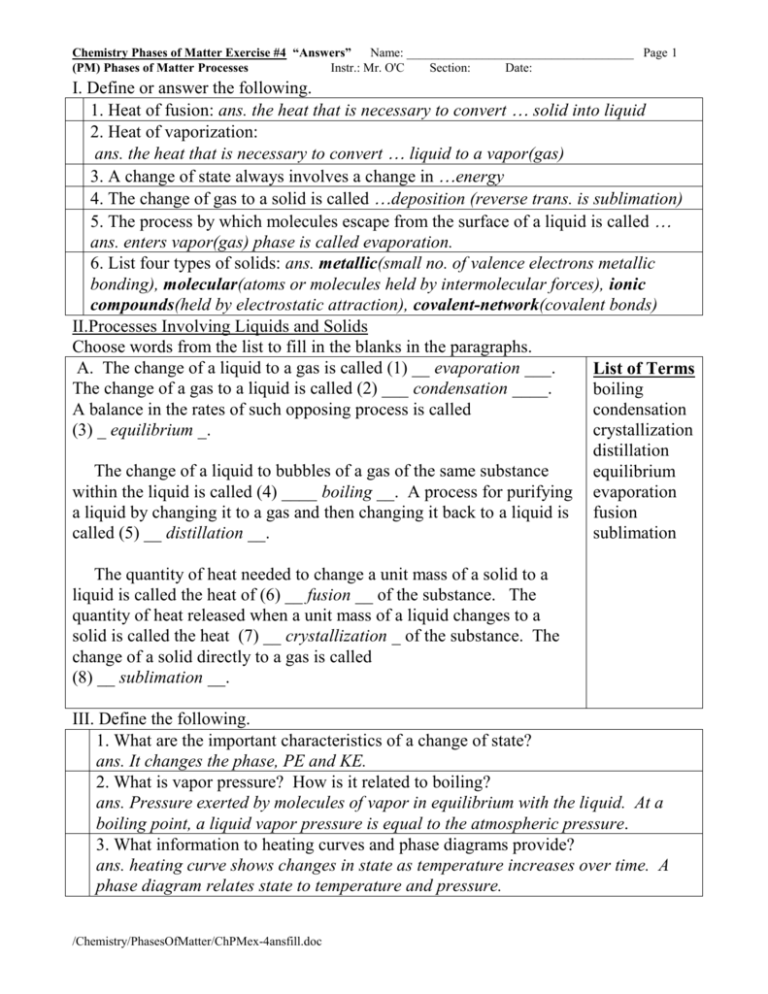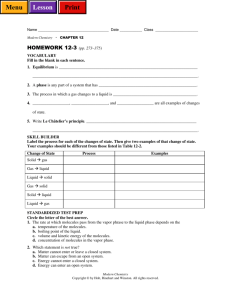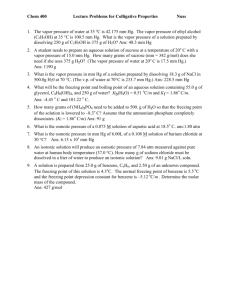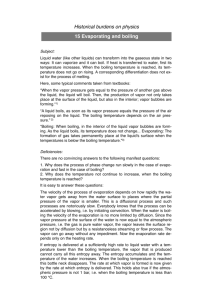How many oxygen atoms are there in each of the following, perhaps
advertisement

Chemistry Phases of Matter Exercise #4 “Answers” Name: ____________________________________ Page 1 (PM) Phases of Matter Processes Instr.: Mr. O'C Section: Date: I. Define or answer the following. 1. Heat of fusion: ans. the heat that is necessary to convert solid into liquid 2. Heat of vaporization: ans. the heat that is necessary to convert liquid to a vapor(gas) 3. A change of state always involves a change in energy 4. The change of gas to a solid is called deposition (reverse trans. is sublimation) 5. The process by which molecules escape from the surface of a liquid is called ans. enters vapor(gas) phase is called evaporation. 6. List four types of solids: ans. metallic(small no. of valence electrons metallic bonding), molecular(atoms or molecules held by intermolecular forces), ionic compounds(held by electrostatic attraction), covalent-network(covalent bonds) II.Processes Involving Liquids and Solids Choose words from the list to fill in the blanks in the paragraphs. A. The change of a liquid to a gas is called (1) __ evaporation ___. List of Terms The change of a gas to a liquid is called (2) ___ condensation ____. boiling A balance in the rates of such opposing process is called condensation (3) _ equilibrium _. crystallization distillation The change of a liquid to bubbles of a gas of the same substance equilibrium within the liquid is called (4) ____ boiling __. A process for purifying evaporation a liquid by changing it to a gas and then changing it back to a liquid is fusion called (5) __ distillation __. sublimation The quantity of heat needed to change a unit mass of a solid to a liquid is called the heat of (6) __ fusion __ of the substance. The quantity of heat released when a unit mass of a liquid changes to a solid is called the heat (7) __ crystallization _ of the substance. The change of a solid directly to a gas is called (8) __ sublimation __. III. Define the following. 1. What are the important characteristics of a change of state? ans. It changes the phase, PE and KE. 2. What is vapor pressure? How is it related to boiling? ans. Pressure exerted by molecules of vapor in equilibrium with the liquid. At a boiling point, a liquid vapor pressure is equal to the atmospheric pressure. 3. What information to heating curves and phase diagrams provide? ans. heating curve shows changes in state as temperature increases over time. A phase diagram relates state to temperature and pressure. /Chemistry/PhasesOfMatter/ChPMex-4ansfill.doc Chemistry Phases of Matter Exercise #4 “Answers” Name: ____________________________________ Page 2 (PM) Phases of Matter Processes Instr.: Mr. O'C Section: Date: B. The water that is sometimes chemically combined in the crystals of a compound is called water of (9) ___ hydration ___. The spontaneous loss of such water at room temperature is called (10) ___ efflorescence __. The removal, by heat, of water that is only mechanically enclosed and not chemically bound in a crystal is called (11) __ decrepitation __. The spontaneous absorption, by a solid, of enough atmospheric moisture to dissolve the solid is called (12) __ deliquescence _. /Chemistry/PhasesOfMatter/ChPMex-4ansfill.doc Crystal study decrepitation deliquescence efflorescence hydration











